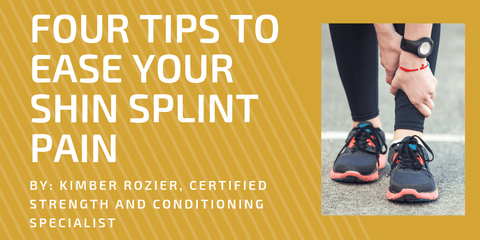Shin Splints Driving You Crazy? Try These Four Tips to Ease Your Pain...
Chronic pain around the inner part of your shin is maddening to anyone attempting to go about their day in a normal fashion. For the active among us, we’re constantly on our feet at work and in recreation. Shin splints severely interrupt a morning ritual of pounding the pavement, with every step sending shooting pain throughout your lower leg.
Fortunately, there are a few things you can do to tackle them. Our top four tips to ease your pain and find some relief are:
- Massage or myofascial release
- Stretching and increasing endurance of lower leg muscles
- Compression
- Proper footwear
But before we get in to all of the above - what exactly are shin splints?
Shin splints, aka Medial Tibial Stress Syndrome, stem from inflammation around the anterior part of your tibia. Often plaguing runners and athletes, repetitive activity overworks the muscle and bone tissue around the shin. Sudden changes in duration or intensity of activity, such as increasing your training to train for a half marathon, can spark pain. That’s because the structure around your medial tibia hasn’t had time to adapt to the new demands.
Other factors contributing to shin splints include:
- Poor arch support from flat feet
- Too high/rigid foot arch
- Worn-out shoes
- Weak musculature
Treatment tip #1: Massage and myofascial release
Weak and tight calf or tibialis anterior muscles cause a loss of laxity and function in the lower leg, stimulating inflammation leading to shin splints. In order to manage some of this pain, loosen things up with massage. Sports massage can be a great treatment for your lower leg. Not only does it break up adhesions, but it can stimulate newly oxygenated blood to the area and facilitate healing.

If a massage isn’t in the cards for you, consider self-myofascial release. A large, standard foam roller serves as a good starting point. For most, a smaller, calf-specific roller hits the target areas better, especially when looking at the deep musculature of the leg.
Be careful to avoid applying direct pressure to the specific pain area, however, as that could just make it worse. You’ll want to release muscles attached to the injured portion instead.
Treatment tip #2: Stretching and strengthening the lower leg muscles
 As shin splints arise from excessive force, training your leg muscles to absorb that force can alleviate symptoms over time. Please note, though, that this does not mean you should go out and run more.
As shin splints arise from excessive force, training your leg muscles to absorb that force can alleviate symptoms over time. Please note, though, that this does not mean you should go out and run more.
First, treatment should loosen up the existing tightness. Utilize straight leg and bent knee calf stretches before adding extra stress with exercise. In addition to light stretches, the following exercises can help gain the necessarily muscular endurance to withstand further demands.
- Eccentric Calf Raises
- Band-resisted dorsiflexion, planterflexion, abduction, adduction, etc.
- Heel/Toe Walks
- Seated Calf Raises
Treatment Tip #3: Wear Compression
 Regularly active individuals hate missing their daily workout. Most of us will fight through a little pain to get through our routine, but that might only make things worse. If you feel an inkling of a shin splint coming on, get a compression sleeve to control inflammation. These lower leg sleeves reduce muscle oscillation and limit unnecessary stress to keep you moving comfortably.
Regularly active individuals hate missing their daily workout. Most of us will fight through a little pain to get through our routine, but that might only make things worse. If you feel an inkling of a shin splint coming on, get a compression sleeve to control inflammation. These lower leg sleeves reduce muscle oscillation and limit unnecessary stress to keep you moving comfortably.
Without compression, your muscles, tendons, and bones continue to battle in a tug-of-war to prove who’s the strongest. Each step adds extra stress. As an external support, wearing good compression helps maintain natural, smooth movement to manage inflammation and damage from running.
Treatment Tip #4: Change your Footwear
Flat or over-arched feet are a final possible culprit of pesky shin splint pain. With improper support and flat feet, the collapsed foot creates a battle for position with the tibialis posterior, a muscle that keeps your arch healthy. Thus, that muscle gets fatigued, pulled in the wrong direction, and stresses the shin at the attachment. Overarching, in contrast, is too rigid to absorb force well. The demands of every step are transferred directly to the bone instead of being absorbed by the arch. This causes dangerous stress on the medial tibia.
Old, worn-out shoes provide minimal support between your foot and the ground, exacerbating the degree of shock absorption by the shin. Analyze your foot shape, whether flat or overarched, and purchase new shoes accordingly.
Especially through the healing process, proper support during weight-bearing is critical. Even more so, returning to action with great shoes will prevent shin splints from reappearing.
Conclusion
Shin splints are a nightmare. There’s no denying that. Any runner or physically active person should take care of their body in advance to prevent them before they start. Refresh your footwear every few months, and keep your lower leg loose and strong through appropriate exercises.
If and when shin splints do happen, compression can be the best short-term solution for relief. As you return to activity, stay mindful of modifying your load, manage the inflammation through compression, and stay diligent with your rehab. Happy running!
Learn, Share, Inspire.


